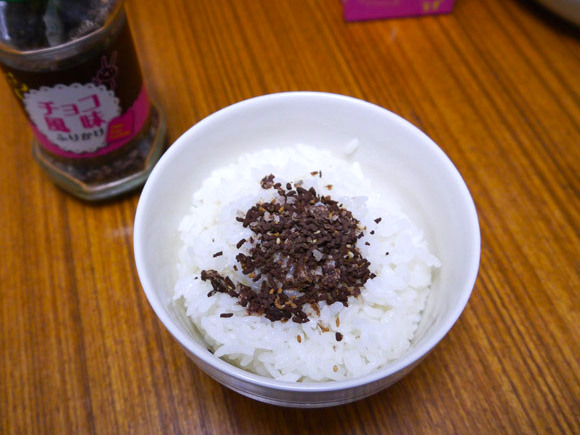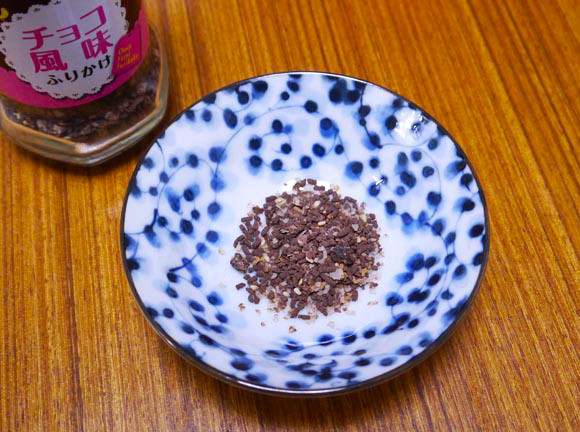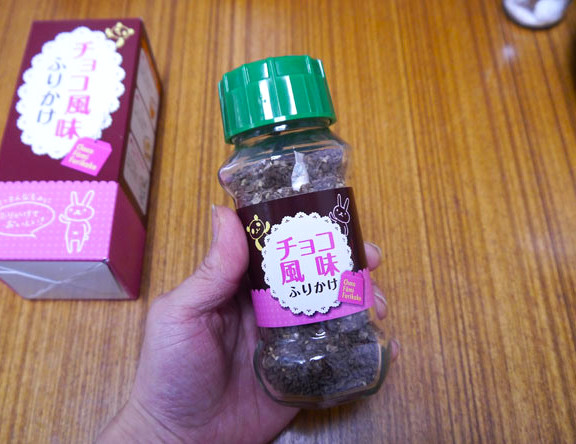
Until recently, rice-loving Americans looking to add a little zing to their favorite grain would need to trek out to the nearest Asian grocery store to pick up a pack of furikake rice topping. But now, according to Japanese media, the toppings are gaining traction on the US west coast and is becoming more widely available.
Furikake consists of a mish-mash of ingredients that have been dried and powdered and, in Japan, is intended specifically and only to be sprinkled atop a steaming hot bowl of sticky Japanese rice; which explains why many Japanese people are reacting with shock at how the Americans are choosing to deploy the condiment.
Japanese news compilation site Naver Matome has gathered a handful of anecdotes from news, blogs, and tweets which claim that, while furikake is gaining more widespread acceptance in the United States, many consumers appear to be using it for sprinkling onto all kinds of different foods that are objectively not white rice.
For starters, it seems that one of the many uses of furikake stateside is as a rub or garnish on things like grilled chicken and seared meats. Additionally, some are even sprinkling it on hot dogs, spam (this is probably referring to spam musubi, the popular Hawaiian/Japanese snack), hamburgers and french fries, popcorn, pastas and salads.
Some Netizens in Japan are pretty happy about furikake’s spread in America, not least because it means they’ll be able to get their hands on it more easily when abroad. Others, however, were disgruntled by the many American recipes that seemed to break the “rules” of furikake use.
Generally speaking, sticky Japanese white rice is unsurprisingly revered in Japan. It’s the staple food of the country and it’s served on the side with most meals. Since most Japanese have enjoyed bowls of fluffy, steamed white rice with nearly every meal since childhood, many consider it an almost perfect foodstuff, not to be defiled by additional flavors and additives, unless said additives or toppings have subtle, complementary flavors. This is why a lot of Japanese people turn up their noses at westerners, who have a perceived tendency to pour soy sauce over their rice.
A Japanese bottle of chocolate furikake, unusual even by Japanese standards
But here’s the rub: if Japanese white rice is such a perfect dish meant to be enjoyed by itself, then why is furikake paradoxically okay on only the one food you’re not supposed to add flavors to? The stuff comes in all kinds of wacky varieties, like wasabi, the above-pictured chocolate, ume plum, bonito… it’s basically just funhouse salt and it’s great. There ought to be a million uses for the stuff, so go America! Heck, put it on your morning Count Chocula cereal if the mood strikes you; I won’t judge. The whole point of food—other than, I guess, that whole keeping you alive thing—is to taste good to the individual consumer, after all…
Source: Naver Matome
Images: RocketNews24



 Sushi and onigiri rice balls get a new look with rollable furikake
Sushi and onigiri rice balls get a new look with rollable furikake Seven fantastic furikake flake flavors to liven up your bowl of white rice
Seven fantastic furikake flake flavors to liven up your bowl of white rice Furikake rice seasoning sales are soaring, which is bad news for Japan as a whole
Furikake rice seasoning sales are soaring, which is bad news for Japan as a whole Japan’s potato chip-flavor rice topping is set to add some snack-time appeal to plain white rice
Japan’s potato chip-flavor rice topping is set to add some snack-time appeal to plain white rice Ultimate bachelor chow recipe: Cheeseburger-style furikake toast【SoraKitchen】
Ultimate bachelor chow recipe: Cheeseburger-style furikake toast【SoraKitchen】 7-Eleven Japan’s ramen-cooking robot whipped us up a bowl of noodles【Taste test】
7-Eleven Japan’s ramen-cooking robot whipped us up a bowl of noodles【Taste test】 Japan’s otoshidama tradition of giving kids money at New Year’s gets a social welfare upgrade
Japan’s otoshidama tradition of giving kids money at New Year’s gets a social welfare upgrade Lacquerware supplier to emperor of Japan and Pokémon team up for new tableware
Lacquerware supplier to emperor of Japan and Pokémon team up for new tableware Former Ultraman actor declared Japan’s Favourite Dad because he “helps out around the house”
Former Ultraman actor declared Japan’s Favourite Dad because he “helps out around the house” Is this the most relaxing Starbucks in Japan?
Is this the most relaxing Starbucks in Japan? Leader of political party that refuses to pay NHK ordered to pay NHK
Leader of political party that refuses to pay NHK ordered to pay NHK Tokyo event lets you travel back in time, for free, to celebrate 100 years since Showa era start
Tokyo event lets you travel back in time, for free, to celebrate 100 years since Showa era start Duolingo to open first pop-up store Duomart in Japan for a very limited time next month
Duolingo to open first pop-up store Duomart in Japan for a very limited time next month The etiquette rules for visiting Shinto shrines in Japan
The etiquette rules for visiting Shinto shrines in Japan Noisy neighbors? Need silence to study? These tiny dogs can help!
Noisy neighbors? Need silence to study? These tiny dogs can help! 7-Eleven Japan starts new temporary luggage storage service in over 300 branches
7-Eleven Japan starts new temporary luggage storage service in over 300 branches Disillusionment at Tsukiji’s tourist-target prices led us to a great ramen restaurant in Tokyo
Disillusionment at Tsukiji’s tourist-target prices led us to a great ramen restaurant in Tokyo Starbucks teams up with 166-year-old Kyoto doll maker for Year of the Horse decorations【Photos】
Starbucks teams up with 166-year-old Kyoto doll maker for Year of the Horse decorations【Photos】 Japan may add Japanese language proficiency, lifestyle classes to permanent foreign resident requirements
Japan may add Japanese language proficiency, lifestyle classes to permanent foreign resident requirements Starbucks Japan releases new zodiac chilled cup drink for 2026
Starbucks Japan releases new zodiac chilled cup drink for 2026 Tokyo’s Tsukiji sushi neighborhood asks tour groups to stay away for the rest of the month
Tokyo’s Tsukiji sushi neighborhood asks tour groups to stay away for the rest of the month Starbucks on a Shinkansen bullet train platform: 6 tips for using the automated store in Japan
Starbucks on a Shinkansen bullet train platform: 6 tips for using the automated store in Japan Street Fighter Hadouken Churros to be launched and eaten in Tokyo, Okami pudding on offer too
Street Fighter Hadouken Churros to be launched and eaten in Tokyo, Okami pudding on offer too Japan’s human washing machines will go on sale to general public, demos to be held in Tokyo
Japan’s human washing machines will go on sale to general public, demos to be held in Tokyo Japanese train company is letting fans buy its actual ticket gates for their homes
Japanese train company is letting fans buy its actual ticket gates for their homes Tokyo considering law requiring more trash cans following litter increase in heavily touristed area
Tokyo considering law requiring more trash cans following litter increase in heavily touristed area Nintendo’s Kirby now delivering orders at Kura Sushi restaurants, but not in Japan
Nintendo’s Kirby now delivering orders at Kura Sushi restaurants, but not in Japan Sanrio theme park in Japan announces plans to expand into a Sanrio resort
Sanrio theme park in Japan announces plans to expand into a Sanrio resort Survey asks foreign tourists what bothered them in Japan, more than half gave same answer
Survey asks foreign tourists what bothered them in Japan, more than half gave same answer Japan’s deadliest food claims more victims, but why do people keep eating it for New Year’s?
Japan’s deadliest food claims more victims, but why do people keep eating it for New Year’s? We deeply regret going into this tunnel on our walk in the mountains of Japan
We deeply regret going into this tunnel on our walk in the mountains of Japan Studio Ghibli releases Kodama forest spirits from Princess Mononoke to light up your home
Studio Ghibli releases Kodama forest spirits from Princess Mononoke to light up your home Major Japanese hotel chain says reservations via overseas booking sites may not be valid
Major Japanese hotel chain says reservations via overseas booking sites may not be valid Put sesame oil in your coffee? Japanese maker says it’s the best way to start your day【Taste test】
Put sesame oil in your coffee? Japanese maker says it’s the best way to start your day【Taste test】 The top 10 annoying foreign tourist behaviors on trains, as chosen by Japanese people【Survey】
The top 10 annoying foreign tourist behaviors on trains, as chosen by Japanese people【Survey】 No more using real katana for tourism activities, Japan’s National Police Agency says
No more using real katana for tourism activities, Japan’s National Police Agency says Starbucks Japan reveals new sakura drinkware collection, inspired by evening cherry blossoms
Starbucks Japan reveals new sakura drinkware collection, inspired by evening cherry blossoms This Christmas you can celebrate by putting a powdered Christmas cake on your rice in Japan
This Christmas you can celebrate by putting a powdered Christmas cake on your rice in Japan Seiji holds the Grand Prix of Marumiya Furikake【Taste Test】
Seiji holds the Grand Prix of Marumiya Furikake【Taste Test】 Teachers say the darnedest things: How rice flavoring is more expensive than a Porsche
Teachers say the darnedest things: How rice flavoring is more expensive than a Porsche New magic powder purports to make natto edible even for bean-haters
New magic powder purports to make natto edible even for bean-haters Pokémon Slowpoke Powdered Rice Topping tastes like liquid for noodles【Taste test】
Pokémon Slowpoke Powdered Rice Topping tastes like liquid for noodles【Taste test】 Fried chicken-flavor rice spread going on sale in Japan to keep your karaage cravings satisfied
Fried chicken-flavor rice spread going on sale in Japan to keep your karaage cravings satisfied Nissin Cup Noodle flavored seasoning for rice?!?
Nissin Cup Noodle flavored seasoning for rice?!? New traditional rice topping selling well, but at 10,000 yen a pop it doesn’t take much
New traditional rice topping selling well, but at 10,000 yen a pop it doesn’t take much How many do you know? 12 delicious foods in Japanese supermarkets and convenience stores
How many do you know? 12 delicious foods in Japanese supermarkets and convenience stores Discount super market’s super cheap bento wows us with its looks, confuses us with its taste
Discount super market’s super cheap bento wows us with its looks, confuses us with its taste Top Secret Cookie Recipe Finally Comes to Light
Top Secret Cookie Recipe Finally Comes to Light 10 things one Japanese expat is always sure to stock up on when returning to Japan
10 things one Japanese expat is always sure to stock up on when returning to Japan Okinawa soul food: We try the most epic pork and egg onigiri rice balls in Japan
Okinawa soul food: We try the most epic pork and egg onigiri rice balls in Japan Survey reveals the top five times Japanese travelers realise just how Japanese they are
Survey reveals the top five times Japanese travelers realise just how Japanese they are Battle of the Rice: Korean Rice Trumps Japanese as Koshihikari Loses Out on Top Spot
Battle of the Rice: Korean Rice Trumps Japanese as Koshihikari Loses Out on Top Spot
Leave a Reply